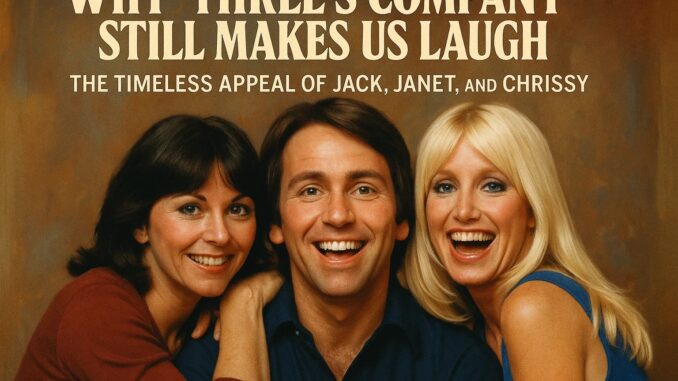
It has been nearly half a century since Three’s Company first aired on ABC in 1977, yet the show continues to entertain new generations of viewers. For a sitcom so deeply rooted in the late 1970s and early 1980s, its ability to remain funny today raises an important question: what makes Three’s Company timeless?
The answer lies in a combination of smart writing, impeccable casting, and comedy rooted in universal themes. The premise was simple: Jack Tripper, played by the incomparable John Ritter, moves in with two female roommates, Janet Wood (Joyce DeWitt) and Chrissy Snow (Suzanne Somers). To appease their landlord, Jack pretends to be gay—a bold concept at the time. The comedic tension came not only from this setup but from the countless misunderstandings, mistaken identities, and slapstick moments that followed.
John Ritter’s performance as Jack was at the heart of the show’s success. His physical comedy—whether tripping over furniture, tumbling to the floor, or contorting his face into expressions of panic—was pure magic. Ritter had a gift for timing, often transforming the simplest gag into an unforgettable scene. His energy and vulnerability made Jack relatable to audiences of all ages.
But Three’s Company wasn’t just about Ritter. Joyce DeWitt’s Janet was the glue of the group, grounding the chaos with intelligence and pragmatism. Suzanne Somers’ portrayal of Chrissy Snow gave the show a spark of innocence and charm, even as her “ditzy blonde” character type drew laughs. Together, the trio created a perfect comedic balance: Jack’s nervous energy, Janet’s sensible wit, and Chrissy’s whimsical naïveté.
The supporting cast added even more color. Don Knotts as the bumbling Mr. Furley and Audra Lindley and Norman Fell as the Ropers delivered some of the series’ most memorable moments. Their exaggerated quirks became as iconic as the main trio’s antics.
What makes the show endure today is not nostalgia alone—it’s the universality of its humor. Anyone can relate to awkward social situations, romantic misunderstandings, or the comedic disasters that happen in daily life. In an era where comedy often relies on fast-paced dialogue or edgy humor, Three’s Company proves that simple situational setups and strong character dynamics can still be laugh-out-loud funny.
The series has also found new life through reruns and streaming, exposing younger audiences to Jack, Janet, and Chrissy. For many, it serves as a time capsule of the late ’70s, with its vibrant fashion, catchy theme song, and breezy Southern California setting. Yet its comedy transcends its era, showing that laughter knows no expiration date.
Ultimately, Three’s Company is more than a sitcom—it’s a reminder of the power of laughter to connect people across generations. Jack, Janet, and Chrissy may belong to another time, but their misadventures continue to feel fresh, familiar, and irresistibly funny.
